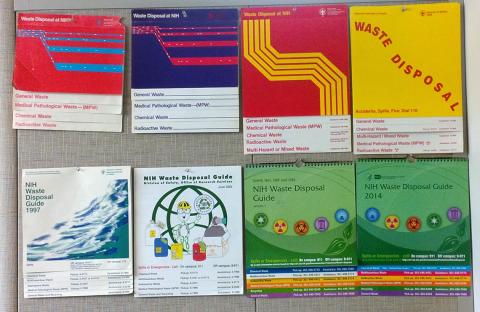Campus Recycling Program Has Come a Long Way

Back in 1990, an NIH Record article about recycling on campus concluded, “Consciousness needs to be raised here on waste issues. There is a continual need to remind workers about proper waste management and reduction.”
Since then, a variety of improvements have been made. In 1997, it became evident that “enthusiastic participation of the floor coordinator” is critical to the successful expansion of the NIH Recycling Program.
A 2006 finding from a leased facility assessment read, “There is a need for a ‘recycling coordinator’ in each area of the building. This may be an entire floor in a building, a division or a department. There should also be a building coordinator.”
The Bethesda campus once had a network of recycling floor and area coordinators. Though volunteers, they were analogous to safety specialists belonging to the Division of Occupational Health and Safety and Division of Logistic Services’ property accountability and custodial officers.
In 2012, an NIH employee put forth this request via a survey: “Make recycling tutorial required training just like ethics and IT security.”
An NIH employee suggested in a 2016 study that recycling information be communicated via department leads.
Recycling can be confusing and training is not obligatory, so as things change over time it helps to know where to go for information. The best place to start is http://nems.nih.gov/Pages/default.aspx.
Improvements in signage will also help lessen the confusion of sorting waste. Clarity of messaging builds confidence in recycling that translates to the most difficult places to sort waste—cafeterias and labs.
For basic desk-side recycling of paper and commingled items (non-laboratory plastic, metal and glass containers) you can use what is most convenient—a box or blue bin. Whatever the means, be sure to empty your desk-side collections into common area recycle bins and sort accordingly.
A 2016 study on campus recycling behaviors uncovered confusion about batteries, electronics and food-contaminated items.

To recycle batteries and lightbulbs from the workplace, call Chemical Waste for an appropriate container or a pick-up at (301) 496-4710.
The NIH Property Management Branch (301-496-4247) handles government electronics and accessories through either reuse or recycle. Your property custodial officer (PCO) can arrange this pick-up. If you don’t know who your PCO is, your IC property accountability officer can assist.
Before recycling, items should be as empty as possible and without heavy residue. Food and liquids are considered contaminants in a general recycle bin.
Organic waste such as food and soiled paper (napkins, paper plates and bowls with heavy residue) are compostable. Food packaging and utensils may be compostable. The Division of Amenities and Transportation Services has adopted numerous best practices including the phase-out of Styrofoam products and increased use of compostable plastic ware.
Unfortunately, local compost facility services are not presently available to campus. Until such an opportunity resurfaces, compostable items are being sent to a waste-to-energy facility along with general trash.
Lastly, the NIH Record is recyclable as mixed paper. It no longer has to be sorted separately as office white paper.
